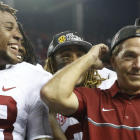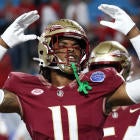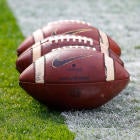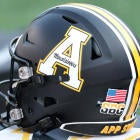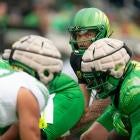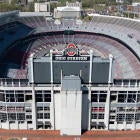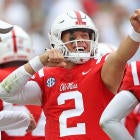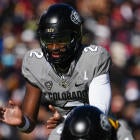"I want everybody here to know, this is not the end. This is the beginning. This team, our fans, our athletics administration has proven that we know what it takes, and we're going to build on that in the future with the players that we have coming back next year and the future players that are building our program into the greatest and the most consistent winning program in the country."
-- Nick Saban on Jan. 16, 2010, at his first Alabama national championship rally after the 2009 season.
Seven years have passed since Greg McElroy was quarterback for the first of Nick Saban's five national titles at Alabama. Recently, McElroy's wife brought up to him what's transpired since then.
"Do you ever find it crazy that you'll be able to tell our grandchildren one day you got to play with this generation's Bear Bryant and you spent time with him every day for four years?" she asked.
"I guess I never really thought of it that way," McElroy said in a recent interview. "Now more than ever, I have such appreciation for all the lessons and experiences we had. It's crazy. I signed at this place with Mike Shula. I'm so freaking lucky the way decisions change outcomes. Am I even in the job I am now (ESPN analyst) without what happened?"
What happened is Saban grabbed control of one of college football's most storied programs and, just a decade later, unfathomably finds himself within one win of Bear Bryant's record six national championships. Times have changed over how national titles get counted, but it's still remarkable.
Saban won one at LSU and four (so far) at Alabama. Bryant needed 19 years to win his six national titles. If Alabama beats Clemson on Monday night, Saban would have won his six rings in 14 years, though actually 12 college seasons since he spent two years in the NFL.
Think about this. With a win over Clemson, Saban would have averaged a national championship every other year since 2003 when coaching in college. He would have five national championships in the past eight years, something that's only been accomplished in college football by Minnesota's Bernie Bierman from 1934-41.
Put aside college football for a minute. If Saban wins Monday, he would join only 11 other coaches/managers from college football, men's and women's college basketball, NFL, MLB, NBA, NHL, WNBA and MLS to ever win five championships over an eight-year period.
Saban has won more games coaching a No. 1 team at one school (44) than any coach in college football history. Woody Hayes (Ohio State) and Bobby Bowden (Florida State) are tied for second with 40 wins each. Alabama has been ranked No. 1 in 36 percent of Saban's games; Ohio State was No. 1 in 17 percent of Hayes' games, and Florida State was No. 1 in 11 percent of Bowden's games.
| Dynasty coaches with at least 4 championships in 7 years | ||
| Coach | Team | Title Dynasty |
| Phil Jackson | Bulls, Lakers (NBA) | 11 in 20 years (1991-2010) |
| John Wooden | UCLA (MBB) | 10 in 12 years (1964-75) |
| Geno Auriemma | Connecticut (WBB) | 10 in 17 years (2000-16) |
| Red Auerbach | Celtics (NBA) | 9 in 10 years (1957-66) |
| Toe Blake | Canadiens (NHL) | 8 in 13 years (1956-68) |
| Joe McCarthy | Yankees (MLB) | 7 in 12 years (1932-43) |
| Casey Stengel | Yankees (MLB) | 7 in 10 years (1949-58) |
| John Kudia | Lakers (NBA) | 5 in 6 years (1949-54) |
| Scotty Bowman | Canadiens (NHL) | 5 in 7 years (1973-79) |
| Bernie Bierman | Minnesota (CFB) | 5 in 8 years (1934-41) |
| Hap Day | Maple Leafs (NHL) | 5 in 8 years (1942-49) |
| Van Chancellor | Comets (WNBA) | 4 in 4 years (1997-2000) |
| Joe Torre | Yankees (MLB) | 4 in 5 years (1996-2000) |
| Glen Sather | Oilers (NHL) | 4 in 5 years (1984-88) |
| Chuck Noll | Steelers (NFL) | 4 in 6 years (1974-79) |
| Nick Saban | Alabama (CFB) | 4 in 7 years (2009-15) * |
| Frank Leahy | Notre Dame (CFB) | 4 in 7 years (1943-49) |
* Listed in bold are coaches who won five titles in eight years, as Nick Saban could achieve Monday. For purposes of this chart, Saban's total only counts his current national title run at Alabama. He also won one at LSU.
After losing to Ole Miss in 2015 for the second straight season, Alabama faced questions if its dynasty was over. Since then, the Crimson Tide have won 16 straight games against ranked Associated Press opponents, tied with USC (2002-05) for the longest streak in history. One more win would give Alabama the record on its own.
"We've never seen anything like it," said Kirk McNair, who used to work for Bryant in Alabama's sports information department and now covers Saban for Bama Magazine. "I keep going over the numbers. It's remarkable."
Like Bryant, Saban evolved over time. Bryant's major evolution came on offense by switching from the pro set to the wishbone entering the 1971 season after losing five games in each of the previous two years.
McNair remembers seeing Bryant draw up wishbone plays on his legal pad during the flight home after ending the 1970 season at the Bluebonnet Bowl. McNair thought nothing of it. The next August, Bryant brought Texas coach Darrell Royal and assistant Emory Bellard, the creator of the wishbone, to a coaching clinic in Tuscaloosa to teach the offense.
"Alabama's coaches learned the wishbone in three to four days before fall camp," McNair said. "Coach Bryant said, 'This is it. We're doing it.' You're expecting this to be a disaster. It turned out to be great and Alabama beats USC in the first game and goes 11-0 in the regular season."
Sound a little familiar? While that's not an apples-to-oranges comparison to this postseason and Saban would have preferred more stability, he abruptly pulled the plug on offensive coordinator Lane Kiffin one week before the National Championship Game. No matter how the decision plays out with Steve Sarkisian calling plays, the decision will now be part of Saban lore, for better or worse.
As most great coaches do, Saban has evolved his offense and defense since his first national title at Alabama. The game changed with tempo, spread offenses, linemen running downfield, dual-threat quarterbacks, and run-pass options. So Saban, somewhat reluctantly at first, changed with it.
"Seven years later, you wouldn't even recognize what they're doing in contrast to 2009," said Alabama radio analyst Phil Savage, a former NFL general manager.
In 2009, Alabama's front seven averaged 281 pounds. In 2016, the front seven averages 263 pounds.
In 2009, Alabama's best linebacker was Rolando McClain at a hefty 260 pounds. In 2016, that title belongs to Reuben Foster at 228 pounds.
In 2009, Alabama had a bulky 3-4 defense with massive players on the defensive line but a limited pass rush. In 2016, Alabama plays in a nickel or dime package with extra defensive backs 70-80 percent of the time and can rush the passer like crazy.
"Whether you're recruiting a linebacker or a defensive lineman, to me, the first thing you have to figure out now is whether he can play all three downs. What's his role on third down?" said Alabama defensive coordinator Jeremy Pruitt, who returned in 2016 to a different style after leaving Tuscaloosa in 2012. "You used to have first and second down and third down changed (personnel). Well, the way the game is now, probably nine out of 12 weeks, first and second down is just like third down, and with these athletic quarterbacks, you've got to have guys who can get them to the ground."
Alabama has 103 sacks in the past two years, including a school-record 53 in 2015, as arguably the most ferocious pass-rushing attack in the game. The Crimson Tide had 88 sacks from 2009-11 when Saban won his first two national titles in Tuscaloosa.
"I can still hear Saban berating (the media) about sacks in 2009 that they didn't matter and he didn't worry about them," McNair said. "His philosophy used to be he wants to affect the quarterback. We always said to ourselves, 'What affects the quarterback more than sacking him?'"
Back in 2009, Alabama huddled, ran the ball and had a very conservative passing game with McElroy, a veteran game manager at quarterback. Today, Alabama goes no huddle with a running, true freshman quarterback in Jalen Hurts.
"I give Coach a ton of credit," Kiffin said last week before getting shown the door. "He could have been really stubborn and said, 'We're gonna run our old offense here, no matter what,' and I don't think we would be sitting here saying we've won three straight SEC championships if he wouldn't have changed."
That Kiffin and Saban managed to stay together for three years -- well, almost -- might have been the biggest upset in the Saban era. They are polar opposites. Ironically, Kiffin perfectly summed up their relationship in one quote while accurately describing Saban and doing just what Saban hated.
"He said to me before, 'Lane, I can take good news, I can take bad news, but don't give me surprises,'" Kiffin said. "So I don't recall a happy moment. I just recall the ass chewings. I won't take that part of the process with me, though."
Said McElroy: "The reason why Alabama is the most consistent program in college football is because Nick Saban is the most consistent person in college football. He's the same guy the Monday before the national championship matchup as he is when you're playing Kent State in Week 1. I've never seen someone so unphased by the previous week's outcome. The motto he spreads throughout the team is, 'So what? What's next?' People think it's crazy, but he doesn't look at it like an eight-year achievement. He looks at it like a daily achievement."
When Saban flew from South Florida to Tuscaloosa in January 2007 as Alabama's next coach, he asked a surprising question to his seatmate, then-Crimson Tide athletic director Mal Moore.
"Do you think you've hired the best coach in the country?" Saban asked Moore, according to Monte Burke's book "Saban: The Making of a Coach."
"Why, Nick, of course I do," Moore said.
"Well, you didn't -- I'm nothing without my players," Saban said. "But you did just hire a helluva recruiter."
McNair said this is the biggest difference between Saban and Bryant. McNair personally thinks Bryant was the best coach, but Saban's plan is much better suited for today's game in an era when recruits eye future multi-million-dollar salaries in the NFL.
"When Coach Bryant was here, Joe Namath got a $400,000 contract in the NFL that was just unheard of," McNair said. "Players would stay a few years in the NFL and say, 'I'm not making enough money,' and go do something else. Saban has built his program by recruiting guys to the NFL. I've heard they've got a notebook with photocopies of all the NFL signing contracts and signing bonuses who have been here under Saban that they show the prospects and their families."
Coaches come go and. Players come and go. Styles come and go. Saban's results stay the same.
If Saban ever allows himself to think about his place in history, he rarely shows it. Instead, he said this week, his motivation comes from the players working hard to create an opportunity for themselves.
"Everybody is working together to try to put them in the best position to have a chance to be successful as people, as students, and as players," Saban said. "That's our challenge, and that's what motivates us. When you play an outstanding opponent, that's something that in and of itself as a competitor is motivation."
McElroy laughed when asked if after 2009 he could have imagined the possibility of five titles in eight years. "Heck no!"
There was, of course, some luck along the way. McElroy remembers Oklahoma State's loss to Iowa State in 2011, opening the door for one-loss Alabama to play a rematch against LSU for the BCS Championship, and the tipped pass at the end of the 2012 SEC Championship Game that Georgia caught in bounds as time expired.
"But they've eliminated luck to a certain extent with tremendous execution," McElroy said. "It's amazing how the season is defined by just a few plays and Alabama seems to make those plays and other teams don't. When the season is on the line, when the play's there to be made, they make it."
Those who have come through the program describe a degree of pressure and accountability placed on everybody within arm's reach of Saban. Savage said he feels the pressure on radio broadcasts with Eli Gold, so he prepares extra hard knowing someone out there listening may know Saban or his family and report what was said.
"I think this is an era of football that will clearly be talked about for 50, 75, 100 years," Savage said. "When Nick Saban hoisted that trophy for the first time and said, 'This is not the end, this is the beginning,' I don't know how anybody, other than the man himself, could have imagined this is where it would be eight seasons later trying to go for a fifth."
Yet here we are. Saban goes for No. 6 to tie Bryant. No one knows when this ends.
"When Coach Bryant was 65 years old (Saban's current age), he was an old man," McNair said. "Nick Saban's not an old man. Whether he can keep this up, I wouldn't bet against him."












